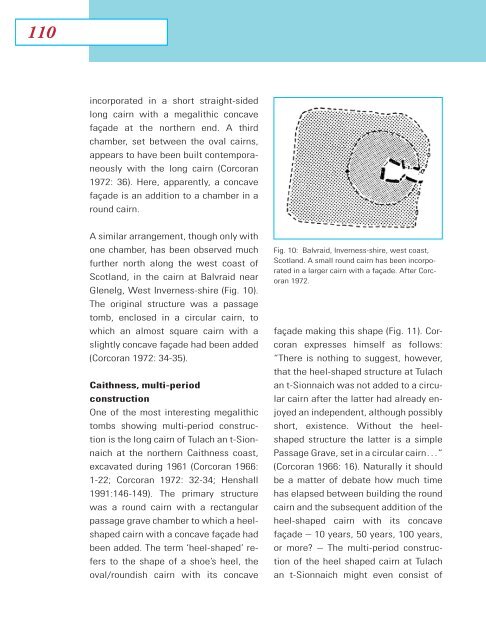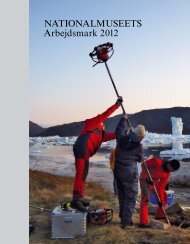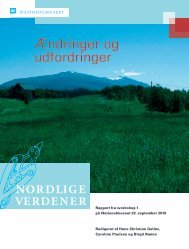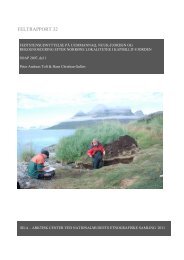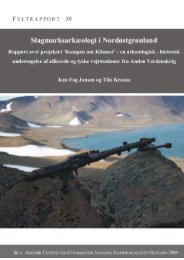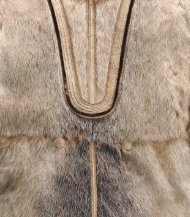The Border of Farming and the Cultural Markers - Nordlige Verdener
The Border of Farming and the Cultural Markers - Nordlige Verdener
The Border of Farming and the Cultural Markers - Nordlige Verdener
You also want an ePaper? Increase the reach of your titles
YUMPU automatically turns print PDFs into web optimized ePapers that Google loves.
110<br />
incorporated in a short straight-sided<br />
long cairn with a megalithic concave<br />
façade at <strong>the</strong> nor<strong>the</strong>rn end. A third<br />
chamber, set between <strong>the</strong> oval cairns,<br />
appears to have been built contemporaneously<br />
with <strong>the</strong> long cairn (Corcoran<br />
1972: 36). Here, apparently, a concave<br />
façade is an addition to a chamber in a<br />
round cairn.<br />
A similar arrangement, though only with<br />
one chamber, has been observed much<br />
fur<strong>the</strong>r north along <strong>the</strong> west coast <strong>of</strong><br />
Scotl<strong>and</strong>, in <strong>the</strong> cairn at Balvraid near<br />
Glenelg, West Inverness-shire (Fig. 10).<br />
<strong>The</strong> original structure was a passage<br />
tomb, enclosed in a circular cairn, to<br />
which an almost square cairn with a<br />
slightly concave façade had been added<br />
(Corcoran 1972: 34-35).<br />
Caithness, multi-period<br />
construction<br />
One <strong>of</strong> <strong>the</strong> most interesting megalithic<br />
tombs showing multi-period construction<br />
is <strong>the</strong> long cairn <strong>of</strong> Tulach an t-Sionnaich<br />
at <strong>the</strong> nor<strong>the</strong>rn Caithness coast,<br />
excavated during 1961 (Corcoran 1966:<br />
1-22; Corcoran 1972: 32-34; Henshall<br />
1991:146-149). <strong>The</strong> primary structure<br />
was a round cairn with a rectangular<br />
passage grave chamber to which a heelshaped<br />
cairn with a concave façade had<br />
been added. <strong>The</strong> term ‘heel-shaped’ refers<br />
to <strong>the</strong> shape <strong>of</strong> a shoe’s heel, <strong>the</strong><br />
oval/roundish cairn with its concave<br />
Fig. 10: Balvraid, Inverness-shire, west coast,<br />
Scotl<strong>and</strong>. A small round cairn has been incorporated<br />
in a larger cairn with a façade. After Corcoran<br />
1972.<br />
façade making this shape (Fig. 11). Corcoran<br />
expresses himself as follows:<br />
“<strong>The</strong>re is nothing to suggest, however,<br />
that <strong>the</strong> heel-shaped structure at Tulach<br />
an t-Sionnaich was not added to a circular<br />
cairn after <strong>the</strong> latter had already enjoyed<br />
an independent, although possibly<br />
short, existence. Without <strong>the</strong> heelshaped<br />
structure <strong>the</strong> latter is a simple<br />
Passage Grave, set in a circular cairn…”<br />
(Corcoran 1966: 16). Naturally it should<br />
be a matter <strong>of</strong> debate how much time<br />
has elapsed between building <strong>the</strong> round<br />
cairn <strong>and</strong> <strong>the</strong> subsequent addition <strong>of</strong> <strong>the</strong><br />
heel-shaped cairn with its concave<br />
façade – 10 years, 50 years, 100 years,<br />
or more – <strong>The</strong> multi-period construction<br />
<strong>of</strong> <strong>the</strong> heel shaped cairn at Tulach<br />
an t-Sionnaich might even consist <strong>of</strong>


